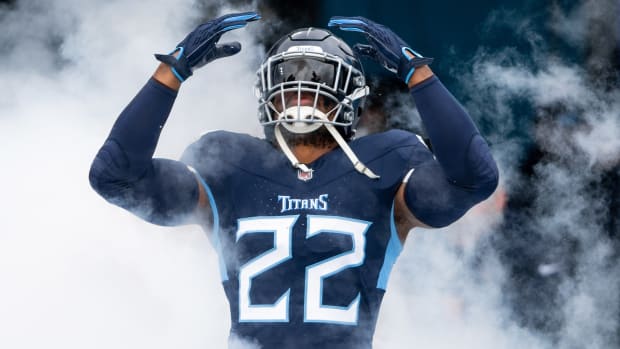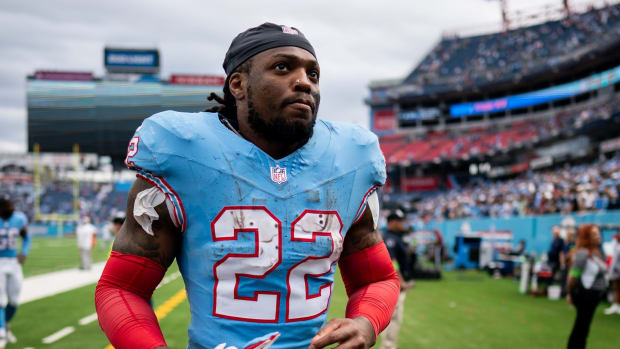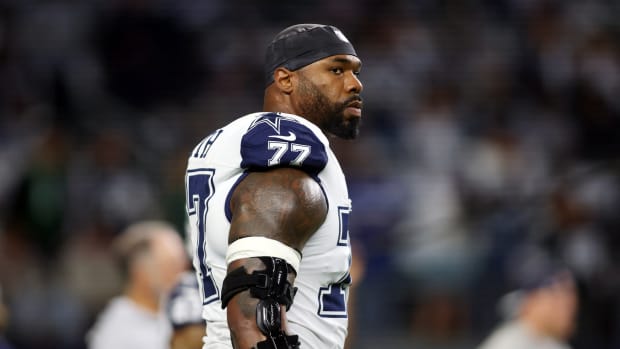Play-Action's Absence a Product of Other Issues
NASHVILLE – Over the past two seasons, the Tennessee Titans turned their play-action passing attack into one of the NFL’s most ruthlessly efficient weapons.
Using the 6-foot-3, 247-pound Derrick Henry as a constant threat, the Titans pulled defenders toward the line of scrimmage and opened space for their wide receivers. When Ryan Tannehill faked the hand-off and looked to pass – either off the bootleg or from the pocket – he found plenty of open receivers.
But play-action was all but absent from Tennessee’s arsenal during Sunday’s season-opening 38-13 loss to the Arizona Cardinals.
The Titans used play-action on just five of their 64 offensive plays against the Cardinals, and the results were disastrous, per Pro Football Focus. Tannehill was pressured on three of the five, resulting in two sacks – including an early one by Chandler Jones that produced a fumble that Arizona recovered. The Titans quarterback completed just one play-action pass, while another attempt was batted down.
Why so little play-action from a team that averaged 12 play-action passes per game in 2020, piling up 1,646 passing yards – the second-highest play-action total in the NFL, per PFF?
There were a few reasons:
• Play-action is successful most often when the defense is on its heels, uncertain whether the next play is going to be a run or a pass. Second-and-medium or second-and-short are perfect scenarios.
But the Titans were especially awful on first down in the early going. In fact, after their first eight, the Titans faced – in order – second-and-13, second-and-11, second-and-8, second-and-16, second-and-11, second-and-10, second-and-8, and second-and-10. Defenses aren’t nearly as worried about the run in those situations.
“Play-action on second-and-12 is not really what you dial it up for,” coach Mike Vrabel said.
Added Cardinals coach Kliff Kingsbury: “That was the plan, and we knew if we could stop the run we could shut down the play-action stuff and get them in third-and-long and make them try to block (Jones). (Defensive coordinator Vance Joseph) had a tremendous plan and executed it perfectly early.”
• One series into the second quarter, Tennessee trailed by three scores, 17-0. That was still the case at halftime as the Cardinals took a 24-6 lead into the locker room. That deficit lessened the likelihood of the Titans running the ball, which in turn lessened the likelihood of play-action surprising the Cardinals.
Arizona didn’t appear too concerned about the running attack in the second half, knowing the Titans needed to throw. So, again, there was no element of uncertainty on the Arizona defense, the kind that leads to successful play-action.
“With that team, once you get a lead on them you have to force them to throw,” Cardinals safety Budda Baker said. “They can’t do their play-action, they can’t run the ball the way they want to, and then try to use those same running formation to throw the ball. You just couldn’t do it.”
• The Titans’ pass protection was horrible for most of the game. Tannehill was not only sacked six times but pressured on 17 of his 43 dropbacks – a rate of almost 40 percent. An argument can be made that more play-action passes might slow the rush, making defenders hesitate for an extra split second. But it also delays the pass itself by an extra split second, and considering the Cardinals weren’t overly worried about the Titans’ running game after building a lead, it often made more sense to simply pass from the shotgun formation.
In any case, the Titans need to find some way to get back to a successful play-action attack, since it’s been a staple of this high-scoring offense for two years.
In 2019, Tannehill posted an NFL-best quarterback rating of 143.3 in play-action passes, and his 13.5-yards per attempt average was tops among NFL starters as well, per PFF. In 2020, Tannehill threw 12 touchdown passes from play-action, the sixth-best figure in the league. His 9.7-yards per attempt was third-best in the NFL on play-action.
Play-action is still very much a part of the Titans’ offense. They just need to be able to use it more than they did against the Cardinals.




